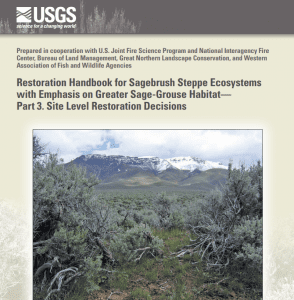Research and Publications
View bulletin.
This bulletin summarizes recent research on biological soil crusts, which are a complex of microscopic organisms growing on the soil surface in many arid and semi-arid ecosystems. These crusts perform the important role of stabilizing soil and reducing or eliminating water and wind erosion. One of the largest threats to biological soil crusts in the arid and semi-arid areas of the western United States is mechanical disturbance from vehicle traffic and grazing. The spread of the annual invasive cheatgrass has increased the fuel load in areas that previously would not carry a fire, posing a potentially widespread and new threat to this resource.
View report.
This study adapted and applied four rangeland health indicators to data compiled by the U.S. Department of Agriculture, Forest Service, Rocky Mountain Research Station’s Forest Inventory and Analysis (FIA) program for research locations on the Fishlake National Forest in central Utah. These data can be used by local forest managers to determine the health status of the local forest and to identify the proportion of sites that may be functioning at risk.
View article.
This study used public land records to characterize livestock grazing across Wyoming, USA, and we used greater sage-grouse (Centrocercus urophasianus) as a model organism to evaluate responses to livestock management. The study found grazing can have both positive and negative effects on Sage-grouse populations depending on the timing and level of grazing. Sage-grouse populations responded positively to higher grazing levels after peak vegetation productivity, but populations declined when similar grazing levels occurred earlier, likely reflecting the sensitivity of cool-season grasses to grazing during peak growth periods.
View article.
This study analyzed data sets from previous and ongoing studies across the Great Basin characterizing cover response of perennial and annual forbs that are consumed by sage grouse to mechanical, prescribed fire, and low-disturbance fuel reduction treatments. Annual forbs favored by sage grouse benefited most from prescribed fire treatments with smaller increases following mechanical and fuel reduction treatments.
View handbook.
This handbook walks managers and practitioners through a number of site-specific decisions managers face before selecting the appropriate type of restoration. This site-level decision tool for restoration of sagebrush steppe ecosystems is organized in nine steps.
- Step 1 describes the process of defining site-level restoration objectives.
- Step 2 describes the ecological site characteristics of the restoration site. This covers soil chemistry and texture, soil moisture and temperature regimes, and the vegetation communities the site is capable of supporting.
- Step 3 compares the current vegetation to the plant communities associated with the site State and Transition models.
- Step 4 takes the manager through the process of current land uses and past disturbances that may influence restoration success.
- Step 5 is a brief discussion of how weather before and after treatments may impact restoration success.
- Step 6 addresses restoration treatment types and their potential positive and negative impacts on the ecosystem and on habitats, especially for greater sage-grouse. We discuss when passive restoration options may be sufficient and when active restoration may be necessary to achieve restoration objectives.
- Step 7 addresses decisions regarding post-restoration livestock grazing management.
- Step 8 addresses monitoring of the restoration; we discuss important aspects associated with implementation monitoring as well as effectiveness monitoring.
- Step 9 takes the information learned from monitoring to determine how restoration actions in the future might be adapted to improve restoration success.
Seventy-five years of vegetation treatments on public rangelands in the Great Basin of North America
View article.
This article summarizes information from land treatments occurring over millions of hectares of public rangelands in the Great Basin over the last 75 years represent one of the largest vegetation manipulation and restoration efforts in the world.
View article.
Based on nearly 25 years of experience at NASA, the University of Georgia, and The Weather Channel, Marshall Shepherd offers nine tips for communicating science to non-scientists.
- Know your audience
- Don’t use jargon
- Get to the point
- Use analogies and metaphors
- Give 3 key points
- You are the expert
- Use social media
- Take your message beyond the journals
- Relate to your audience
View fact sheet.
Numerous agencies, organizations, and collaboratives conduct activities related to wildland fire. Understanding all of their different roles and objectives can be confusing. This fact sheet provides brief descriptions of some of the most common wildland fire initiatives, programs, networks, and other efforts taking place around the country.
View article.
This study found that insects generally reduced the severity of subsequent wildfires. Specific effects varied with insect type and timing, but both insects decreased the abundance of live vegetation susceptible to wildfire at multiple time lags. By dampening subsequent burn severity, native insects could buffer rather than exacerbate fire regime changes expected due to land use and climate change. In light of these findings, the researchers recommend a precautionary approach when designing and implementing forest management policies intended to reduce wildfire hazard and increase resilience to global change.
View synthesis.
This short synthesis highlights findings of the national Fire and Fire Surrogates Study, which conducted an integrated network of experiments at 13 sites across the United States, many of which took place on National Forest lands. Results suggest that more species increased in number than decreased. For example, researchers reported that populations of western bluebirds (Sialia mexicana) increased following prescribed fire; whereas mountain chickadees (Poecile gambeli) decreased in response to thinning treatments. The positive and negative responses of deer mice (Peromyscus maniculatus), gray-collared chipmunks (Tamias cinereicollis) and least chipmunks (T. minimus) varied among the sites; but the overall biomass of small mammals increased in response to the fire treatments. Researchers also found that small mammals’ responses were related to fire uniformity: the more heterogeneous the post-fire landscape, the greater the proportion of positive responses.


